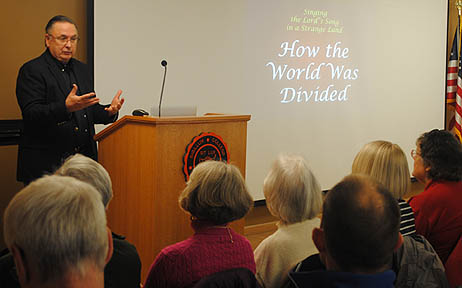
In the second lecture session, Dr. Jim Miller discussed the modern science period and the development of a dualism between faith and reason.
The development of a dualism between science and Christianity was explored Tuesday during the second session of the annual Theologian-in-Residence lecture series at Tusculum College.
The period of modern science and its relation to Christianity were the focus of the session, led by Dr. Jim Miller, president of the Presbyterian Association on Science, Technology and the Christian Faith. The lecture series, now in its 25th year, is sponsored by Tusculum College and partially funded by Ron Smith.
Dr. Miller, described the modern science period as lasting from the time of Galileo during the Renaissance to Richard Dawkins, an evolutionary biologist who came to prominence in the 1970s. Although Copernicus has been called the “father of modern science,” he added that the moniker “grandfather of modern science” might be a better description as his objections to an earth-centered solar system were from a classical world viewpoint and his mathematical solution was an earlier idea that had been espoused by the Pythagoreans.
However, Galileo was different in that his objections were based on what he observed through a telescope. Galileo “saw amazing things that differed from the Aristotelian ideas of the day,” said Dr. Miller, who is an ordained Presbyterian minister and currently the co-chair of the Broader Social Impact Committee of the Human Origins Program at the Smithsonian’s National Museum of Natural History.
While Galileo had evidence that the Aristotelian cosmology was not correct, he still lacked empirical proof to back his assertion that the earth rotated around the sun, Dr. Miller continued. Galileo’s teachings about a heliocentric solar system resulted in a conflict with the Catholic Church at the time of the Protestant Reformation. He was ordered to stop writing about or teaching the Copernican idea about the solar system. “To challenge the Aristotelian ideals seemed to be a challenge to Christian theology because Aquinas had intertwined Aristotelian ideals so much into his theology,” he explained.
After a new pope was installed with whom Galileo had corresponded about the idea of the heliocentric solar system, the Italian astronomer hoped the church’s stance would change. However, after Galileo wrote “Dialogue Concerning the Two Chief World Systems” promoting the heliocentric solar system, he was brought to trial by the Church and forced to recant belief in that idea.
Galileo spent his last years under house arrest and wrote his two most important scientific works, books about two sciences now called kinematics and strength of materials, Dr. Miller said.
One of Galileo’s lasting contributions to science was the establishment of the method of making a hypothesis, testing that hypothesis, analyzing the results and reaching conclusions, he added.
The period between Rene Descartes and Immanuel Kant saw a consolidation of modernity and the establishment of the basic core and shape of the modern worldview, Dr. Miller said. In this worldview, the prevailing metaphor is the machine, he continued. For example, Descartes initiated the idea that the body is a “meat machine” to be understood and repaired like a machine.
Rather than knowledge being derived from ordinary sensory experience, logic and intuition as in the classical worldview, in the modern worldview, knowledge comes from analytic deduction, dividing an object into its component parts and studying those parts. In the modern view “to be reasonable is to be logical,” he said.
While causality in the classical world was thought of more as determined by purpose, in the modern view, it is mechanical – one thing strikes another and causes it to act, Dr. Miller continued.
“In our modern culture, our inclination is to treat issues as though they were problems,” he said. “We act as if though we get the system right, everything will come out fine.”
However, he said, problems are situations that there may be one or two definite technical solutions, while issues are resolved by agreement between the parties involved and gave an example of building a bridge – how to build the bridge involves technical problems while whether or not to build the bridge is an issue.
With the scientific developments, a duality began to form between science and religion as individuals grappled with how they could be reconciled. “They thought that faith is one thing and scientific inquiry is something else,” Dr. Miller said.
Dr. Miller listed some of the divisions that have been defined, such as sacred versus secular, revelation versus science, God’s truth versus man’s truth. Over time the line between the two divisions has become defined by the “versus” with both sides vying to be the one that is considered as correct, he continued. “But why the versus?”
The series will continue on Feb. 17 with a focus on our current period, which Dr. Miller describes as the “emerging world” and conclude on Feb. 24 with a look at the theological implications of the history reviewed in the previous lectures for practical Christian living in the 21st century.
The sessions begin at 10 a.m. in the Chalmers Conference Center in the Niswonger Commons on the Tusculum College campus. There is no charge to attend the lecture series, but reservations are required as lunch is provided in the college’s cafeteria. To register or for more information, please call 423-636-7304 or email eestes@tusculum.edu.


